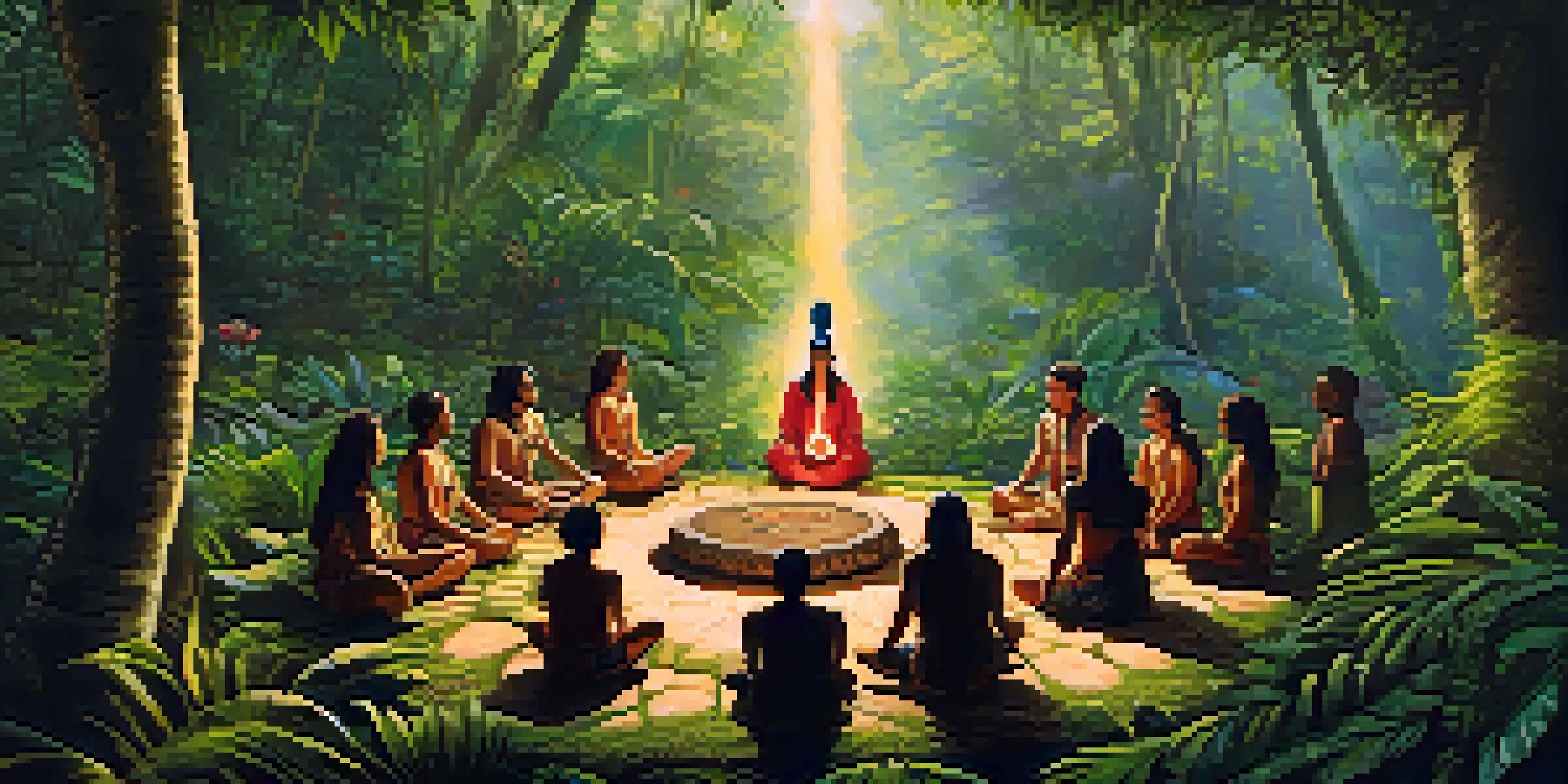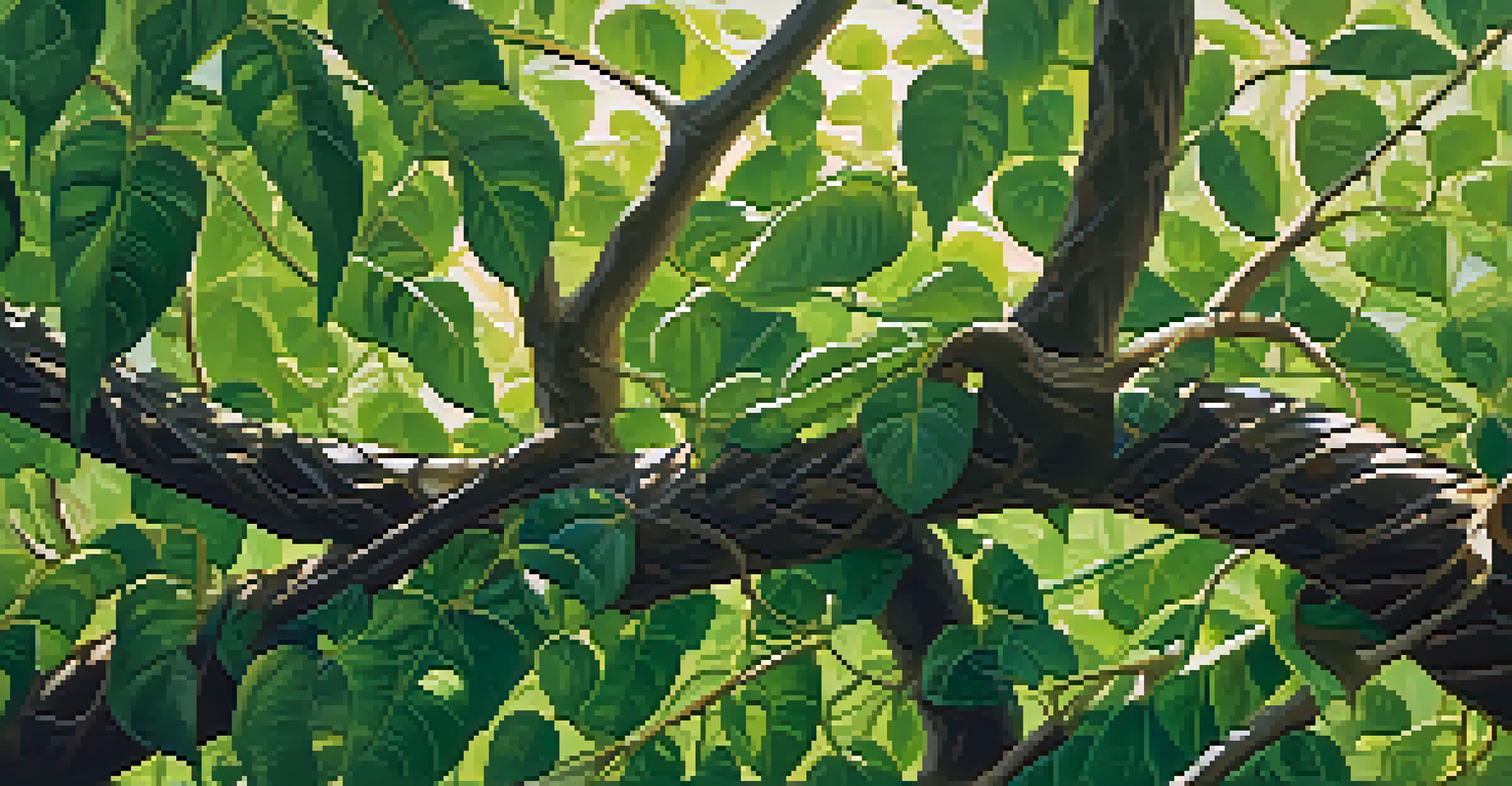Ayahuasca Tourism: Globalization's Double-Edged Sword

Understanding Ayahuasca and Its Cultural Roots
Ayahuasca is a powerful brew made from the Banisteriopsis caapi vine and other plants, traditionally used by Indigenous tribes in the Amazon for spiritual and healing purposes. This sacred drink is deeply intertwined with the cultural practices of these communities, offering insights into their worldview and connection to nature. Understanding its roots is crucial, as it shapes the experiences of those who seek it outside its native context.
The experience of ayahuasca can lead to profound personal transformation, but it is important to approach it with respect and an understanding of its cultural significance.
For many, ayahuasca represents a pathway to profound personal transformation and spiritual awakening. However, this desire often leads to misinterpretations of its significance, as tourists may engage with the substance without an understanding of its cultural context. This disconnect raises questions about respect, authenticity, and the implications of commodifying such a sacred practice.
As ayahuasca gains popularity globally, it becomes essential to honor its origins while recognizing the potential benefits and risks involved. The intersection of traditional knowledge and modern tourism creates a complex landscape that demands careful navigation to ensure both cultural respect and personal safety.
The Rise of Ayahuasca Tourism: A Global Phenomenon
In recent years, ayahuasca tourism has surged, attracting seekers from around the world to South America. Destinations like Peru and Brazil have become hubs for those looking to experience ayahuasca ceremonies, often led by shamans or facilitators. This influx of tourists not only boosts local economies but also introduces a broader audience to indigenous healing practices.

However, the rapid growth of this tourism sector raises concerns about sustainability and ethical practices. With the commercialization of ayahuasca, there is a risk of diluting the authenticity of traditional ceremonies. Some shamans may prioritize profit over genuine spiritual guidance, leading to exploitative situations for both the healers and the participants.
Cultural Significance of Ayahuasca
Ayahuasca is deeply rooted in Indigenous traditions, serving as a spiritual and healing tool that reflects the cultural practices of Amazonian communities.
Moreover, the increase in demand can put pressure on local ecosystems and communities, as more tourists seek these experiences. Balancing the economic benefits of tourism with the preservation of cultural heritage and environmental sustainability is a challenge that requires conscious efforts from all involved.
Cultural Appropriation vs. Cultural Exchange
As ayahuasca tourism expands, discussions around cultural appropriation versus cultural exchange become increasingly relevant. Cultural appropriation refers to the adoption of elements from one culture by members of another, often without permission or understanding. This can lead to the exploitation of marginalized cultures, raising ethical questions about who benefits from these practices.
Cultural exchange can foster understanding and appreciation, but it must be done thoughtfully to avoid the pitfalls of cultural appropriation.
On the other hand, cultural exchange emphasizes mutual respect and learning between cultures. When approached thoughtfully, ayahuasca tourism can foster understanding and appreciation of Indigenous traditions. It’s vital for tourists to engage with these practices in a way that honors their origins, ideally through partnerships with local communities.
Navigating this delicate balance requires awareness and sensitivity. Tourists must be informed about the cultural significance of ayahuasca and the importance of supporting local practitioners who uphold the traditions with integrity.
The Impact on Indigenous Communities
The influx of tourists seeking ayahuasca experiences can dramatically impact Indigenous communities. While some locals may benefit economically, others worry about the commodification of their sacred traditions. As more outsiders participate in ayahuasca ceremonies, there’s a risk of overshadowing the authentic practices and voices of the Indigenous people who have safeguarded this knowledge for generations.
Additionally, the presence of tourists can lead to cultural dilution, where traditional practices are altered or simplified to cater to foreign expectations. This shift can undermine the spiritual significance of the ceremonies and lead to a loss of cultural identity among Indigenous peoples. It’s essential to recognize the potential consequences of this tourism trend on community dynamics.
Challenges of Ayahuasca Tourism
The rise of ayahuasca tourism raises concerns about the commodification of sacred practices, potential exploitation, and the impact on local communities.
Supporting Indigenous-led initiatives and respecting their autonomy is crucial in mitigating these impacts. Tourists should seek authentic experiences that empower local communities rather than exploit them, ensuring that their engagement fosters cultural preservation rather than deterioration.
The Role of Modern Facilitators
Modern facilitators and shamans play a significant role in the ayahuasca tourism landscape. While some have deep roots in Indigenous traditions, others may lack the necessary knowledge or experience, leading to varied levels of authenticity in the experiences offered. This disparity can create confusion for tourists, who may struggle to discern genuine practices from opportunistic ventures.
The training and background of these facilitators are essential for ensuring safe and respectful ceremonies. Trustworthy guides should emphasize the importance of preparation and integration, helping participants navigate the emotional and psychological effects of their experiences. A facilitator's role goes beyond simply leading a ceremony; it encompasses a commitment to the well-being of their participants.
As tourists seek authentic ayahuasca experiences, they must do their research and choose facilitators who prioritize ethical practices and cultural respect. Engaging with those who honor the traditions and provide a safe space for exploration can lead to meaningful journeys for both tourists and Indigenous communities.
Personal Transformation and Its Risks
Many individuals seek ayahuasca for personal transformation, hoping to address mental health challenges, trauma, or spiritual crises. The potential for profound insights and healing can be alluring, but it’s crucial to approach these experiences with caution. Ayahuasca can evoke intense emotional responses, and not everyone is prepared for the journey it entails.
While some people report life-changing revelations, others may struggle with difficult emotions or experiences during ceremonies. It's essential for participants to have realistic expectations and understand that not every journey will lead to clarity or healing. Support systems and integration practices post-ceremony can be vital for processing the experience.
Importance of Ethical Practices
Responsible ayahuasca tourism requires participants to engage thoughtfully with local cultures, prioritizing ethical considerations and supporting Indigenous-led initiatives.
Additionally, the physical effects of ayahuasca should not be overlooked. The brew can induce purging and other intense reactions, which can be challenging for some. Participants must prioritize their well-being and seek guidance from experienced facilitators to navigate these risks effectively.
Towards Responsible Ayahuasca Tourism
As ayahuasca tourism continues to grow, establishing guidelines for responsible practices is crucial. Tourists should prioritize ethical considerations by choosing facilitators who are transparent about their practices and have the community's best interests at heart. This approach not only benefits participants but also supports the preservation of Indigenous cultures.
Education plays a vital role in fostering responsible tourism. Tourists should take the time to learn about ayahuasca's cultural significance, the history of the communities involved, and the potential impacts of their participation. This knowledge can empower them to make informed decisions and engage respectfully with local traditions.

Ultimately, responsible ayahuasca tourism hinges on mutual respect and collaboration. By fostering meaningful connections between tourists and Indigenous communities, we can create a more enriching experience while ensuring the sustainability of these sacred practices for future generations.